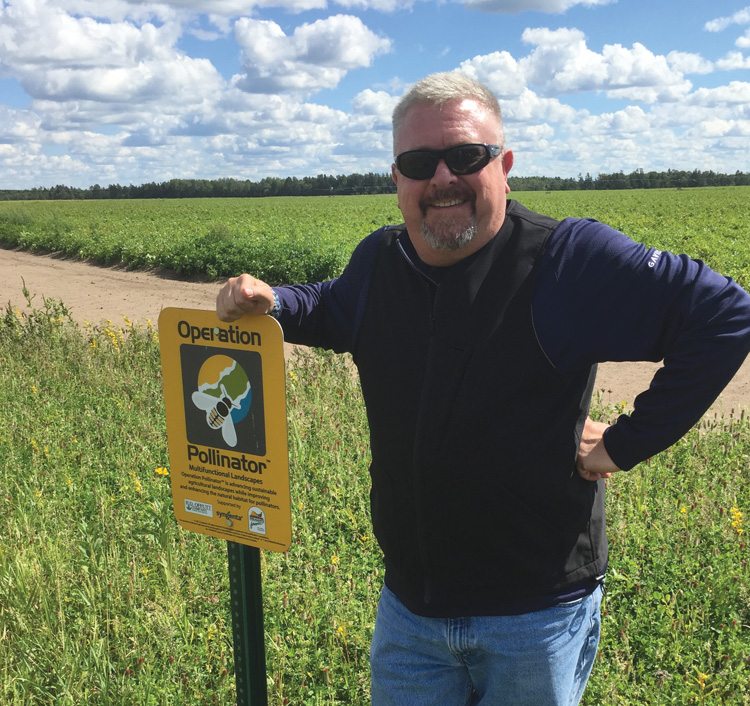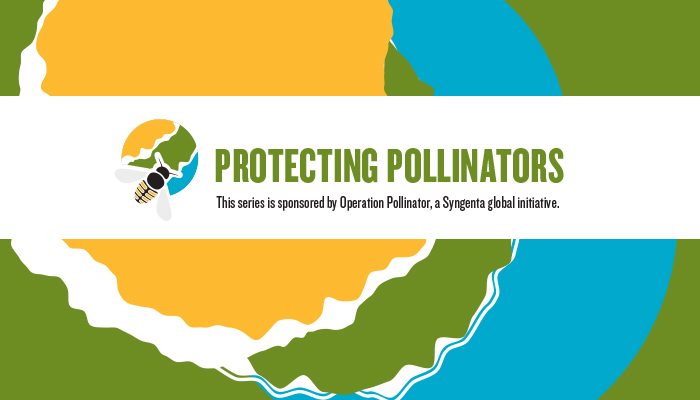Through dialogue, change is beginning to take shape.
The media may sometimes portray farmers and beekeepers as being on opposite sides, but the two groups are actually both striving for the same goal: feeding a growing population while protecting the world we live in.
Coexistence is crucial, but there has still been a great deal of blame in recent years as reports of colony collapse disorder hit headlines. Vince Restucci, director of procurement and business technology for the farm division of R.D. Offutt Company, a Minnesota potato operation, believes such attention may have started off in a negative light, but has led to positive change by opening a dialogue.
“There has been a lot of finger-pointing — primarily from those outside the ag sector, but there has also been a lot of interest in finding sustainable solutions and many opportunities to educate and inform the public on what farmers are doing to help support pollinators,” he says.
Syngenta has a long history of biodiversity enhancement projects. Romano De Vivo, head of environmental policy for Syngenta, was instrumental in beginning the company’s Operation Pollinator program in Europe more than 15 years ago. He believes conversation is the key to coexistence.
“The more we can involve people in the conversation, the better,” he says.

The Conversation
The conversation often begins with a single idea. Perhaps a beekeeper asks about a specific pesticide being sprayed near his hives. Or a farmer asks how to add pollinator habitat to his land. However, to be effective, these conversations must address the full spectrum of factors that play a part in bee health, including habitat, diseases, parasites, beekeeper practices, climate change and poor nutrition, as well as chemicals.
De Vivo sees the overall solution being assembled like building blocks, each piece of the conversation brings an important element toward creating a solid foundation for the future of agriculture.
“Each element is important to consider,” he says.
Communicating Coexistence
“When we look at studies, it’s clear bees are healthier and better able to defend themselves when they have access to a variety of pollen and nectar sources,” De Vivo says.
So, De Vivo encourages farmers who want to take a first step toward investing in pollinators to convert a small area of less productive land into a habitat for wildlife. This can be done by planting trees, flowers or bushes.
By partnering with the National Potato Council and Syngenta’s Operation Pollinator program, R.D. Offutt Company jumped into this effort in a big way.
The company maintains more than 1,000 acres of pollinator plots across the Midwest and has converted the corners of its potato fields, where water from center-pivot irrigation systems does not reach, to pollinator habitats.
“This was really the start of the conversation for us in asking how we could help,” Restucci says. “We already had a commitment to increasing biodiversity and not farming in a monoculture as part of our basic stewardship principles. Maintaining pollinator habitats allowed us to take that to the next level.”
The company also planted more than 150,000 trees, which creates additional habitat and prevents erosion, adding to the overall environmental health.
Restucci says one important step in the process is communicating with consumers.
“We’ve had a lot of interest from people just driving by, because these plots are immediately recognizable as something new and different. There were a lot of questions from people who didn’t understand what we were trying to do, asking why we were changing grassy areas and how this would help the bees,” he says.
Signage can help answer some of those questions, but creating a dialogue with consumers and passersby is just another way to expand the impact.
“Some people were skeptical at first, but we’ve seen more interest in planting wildflowers near walkways, or in areas near roads or hospitals. It’s been great to see these efforts expand even outside the plots we planted as the program continues to grow,” Restucci says.
Talking about the finances is also important within the industry as we look for sustainable solutions that can be implemented by farmers across the country. Restucci says habitat creation was extremely affordable, thanks to seeds provided through the Operation Pollinator program.
“It ended up costing us only about $7 an acre to establish the habitats,” he says.
Of course, the value of the project is worth far more.
“These plots are teeming with wildflowers and insects and bees. It’s been a huge success. Plus, the dialogue we’ve created has allowed us to exchange information with members of the local community.
Efforts such as these are crucial in creating the symbiotic relationship we need to coexist in this world,” Restucci says.

Continue the Dialogue
The conversation doesn’t stop at simply creating habitat plots. It’s important to continue working to evaluate and improve those efforts.
“Once you have created a habitat, its function as refuge for pollinators can be evaluated and should be protected. Linking up these biodiversity-rich areas can create inter-connected functional habitats and wider opportunities for conservation,” De Vivo says.
R.D. Offutt Company works to further research and support their habitat program in a variety of ways, including working with Pheasants Forever and the Minnesota Deer Hunters Association.
“We’ve created an advisory team to help us look at the land and optimize the habitats for the bees,” says Anne Struthers, director of communications for R.D. Offutt Company.
As they move forward, Restucci is also aware that the industry has begun to truly embrace a focus on pollinator health. Before, beekeepers were sort of outsiders in the agriculture world, but he believes that’s changing.
“Some farmers even viewed beekeepers more as a vendor, offering a service to those crops that needed pollination, but now, it’s seen more as a partnership,” he says. “We’re learning ways to better work together.”
De Vivo adds: “Taking the first step to connect to the local beekeeping community and provide clear information about the position of hives and timing of farming activities is important.”
For example, that single conversation might lead to a big impact decision, such as reducing potential pesticide exposure by scheduling applications later in the day when the bees are back in their hives.
It’s not too late for true coexistence, but now is the time to start talking about real solutions.
“If we don’t start bridging the gap, we’ll continue to create a divide,” Restucci says. “An ‘us versus them’ mentality is not a healthy relationship when we’re trying to have the conversations that will bring about change
DeVivo agrees.
“Ideally, the entire agricultural community should be working together, talking to each other about their activities, working to improve the world together,” he says. “Our hard work is dependent on engaging stakeholders to stimulate dialogue and explore simple and pragmatic environmental solutions.
“This is what we strive to achieve with our Good Growth Plan, Syngenta’s commitment to help farmers meet agricultural challenges sustainably.”











